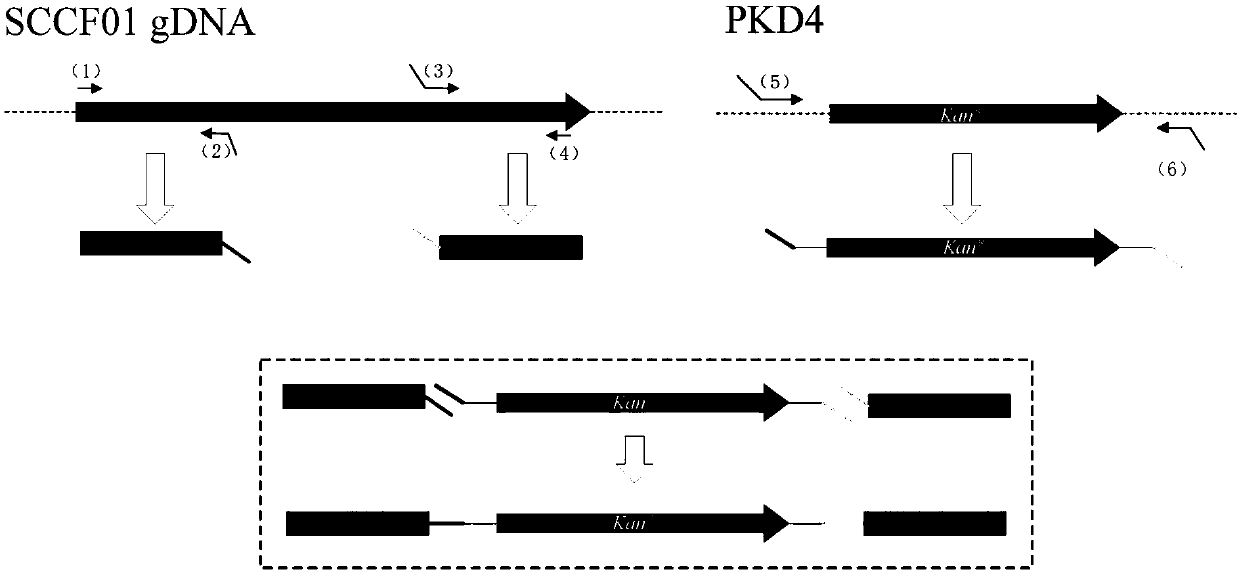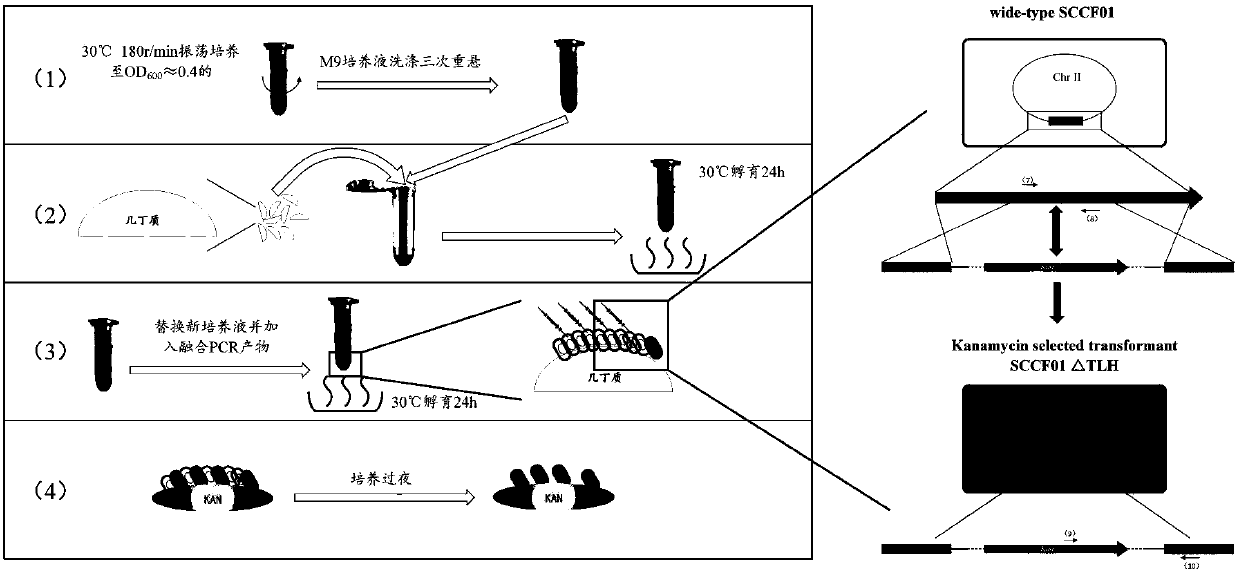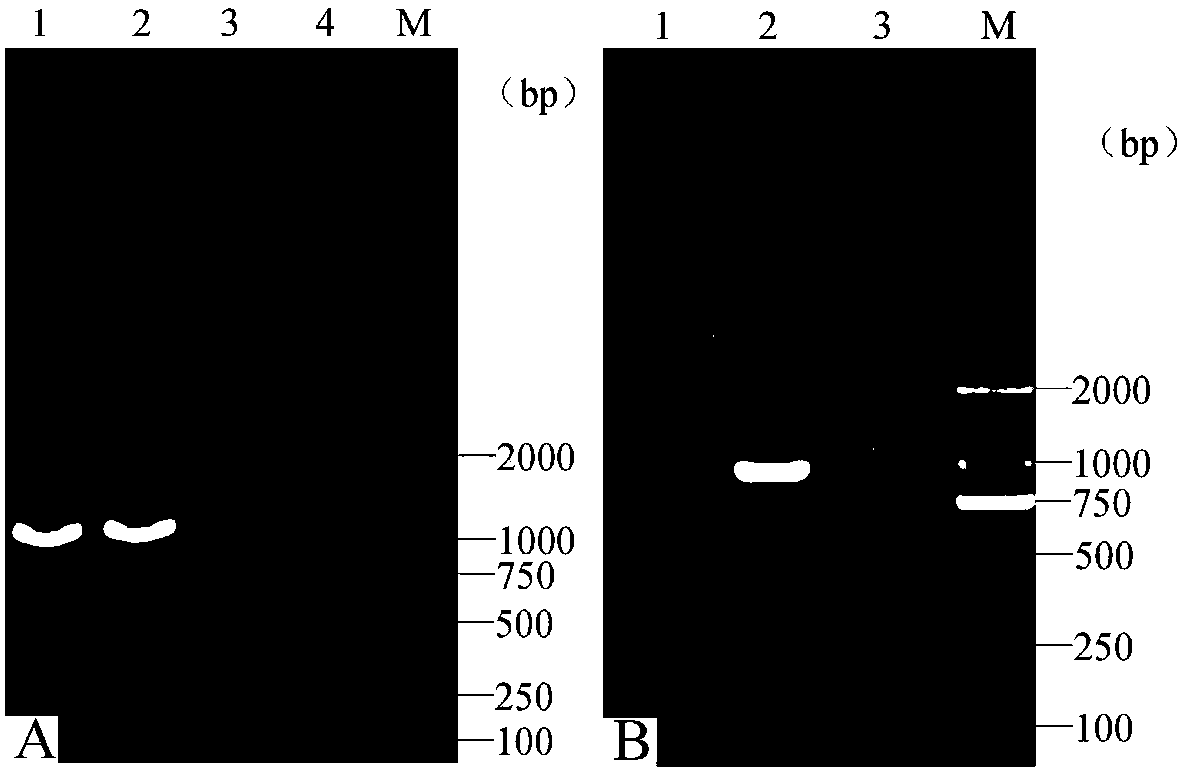Vibrio mimicus efficient genetic combination method based on natural conversion and application
A technology of mimetic vibrio and genetic recombination, applied in the field of efficient genetic recombination of mimetic vibrio, can solve the problems of low knockout efficiency, low recombination efficiency, cumbersome operation, etc. Effect
- Summary
- Abstract
- Description
- Claims
- Application Information
AI Technical Summary
Problems solved by technology
Method used
Image
Examples
Embodiment 1
[0036] Step 1. Construction of targeting fragments: Use bacterial genome DNA extraction kit (DP302) to extract the genome of Vibrio mimeticus SCCF01 strain (preserved in the Department of Basic Veterinary Medicine, College of Veterinary Medicine, Sichuan Agricultural University, number: CVM2013034), using the genome of SCCF01 strain as a template, Use the target gene upper arm and the target gene lower arm primer pair to amplify the target gene upper arm sequence and lower arm sequence, use the PKD4 plasmid as a template, use the Kan primer pair to amplify the kanamycin resistance gene fragment, and perform overlapping PCR amplification;
[0037] The reaction systems for PCR amplification of the three DNA fragments are: Buffer10μl, dNTPMixture 4μl, upstream and downstream primers (10μM) 1μl each, template 1μl, DNA Polymerase (2.5U / μl) 0.5μl, ddH 2 O32.5ul; PCR amplification conditions: pre-denaturation at 98°C for 3min; denaturation at 98°C for 10s, annealing at 60°C for 10s,...
Embodiment 2
[0052] Embodiment 2 takes TLH as the genetic recombination method of the target gene
[0053] 1. Construction of targeting fragments
[0054] Use bacterial genome DNA extraction kit (DP302) to extract the genome of Vibrio mimicus SCCF01 strain (preserved in the Department of Basic Veterinary Medicine, College of Veterinary Medicine, Sichuan Agricultural University, number: CVM2013034), using the SCCF01 strain genome as a template, using TLH-UP-F, R and TLH-DOWN-F, R (Table 1) two pairs of primers respectively amplify TLH upstream and downstream homology arms (nucleotide sequences are shown in SEQ ID NO.1 and SEQ ID NO.2 respectively); with PKD4 plasmid As a template, Kan-F, R primers (Table 1) were used to amplify the kanamycin resistance gene fragment (nucleotide sequence shown in SEQ ID NO.3). The reaction systems for PCR amplification of the three DNA fragments are: Buffer 10μl, dNTP Mixture 4μl, upstream and downstream primers (10μM) 1μl each, template 1μl, DNA Polyme...
Embodiment 3
[0066] Example 3 Verification of the reliability of Vibrio mimicus genetic recombination method
[0067] In order to further confirm the reliability of the genetic recombination method, this study further constructed the deletion strains of TonB1 single gene, ExbB1-ExbD1 double gene deletion and ExbB1-ExbD1-TonB1 three gene deletion (see Table 2 for the amplification primers); according to Example 1 The method first uses specific primers to amplify the upper arm sequence and lower arm sequence of the target gene, and at the same time amplifies the corresponding kanamycin resistance gene, and then uses the above three fragments as templates to perform overlapping PCR amplification. The obtained PCR product was recovered and purified according to step 3) for natural conversion after gel cutting. Natural Transformation Method:
[0068] a) Inoculate the recipient bacteria on TCBS agar medium, culture at 30°C for 24 hours, pick a single colony and inoculate it in 10ml of LB liquid...
PUM
 Login to View More
Login to View More Abstract
Description
Claims
Application Information
 Login to View More
Login to View More - R&D
- Intellectual Property
- Life Sciences
- Materials
- Tech Scout
- Unparalleled Data Quality
- Higher Quality Content
- 60% Fewer Hallucinations
Browse by: Latest US Patents, China's latest patents, Technical Efficacy Thesaurus, Application Domain, Technology Topic, Popular Technical Reports.
© 2025 PatSnap. All rights reserved.Legal|Privacy policy|Modern Slavery Act Transparency Statement|Sitemap|About US| Contact US: help@patsnap.com



